Gigabyte's i-RAM: Affordable Solid State Storage
by Anand Lal Shimpi on July 25, 2005 3:50 PM EST- Posted in
- Storage
Using the i-RAM
To begin our testing, we loaded up the i-RAM with four 1GB DDR400 sticks. We didn't have any large DDR200 modules, so unfortunately we had to go with more modern DDR400. Using DDR500, DDR400 or DDR200 doesn't change performance at all, since the Xilinx controller runs them all at the same frequency.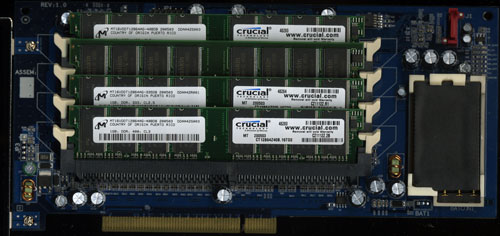
Powering the system on revealed the installation was a success; the BIOS reported the presence of the i-RAM as a regular storage device connected to our SATA controller:

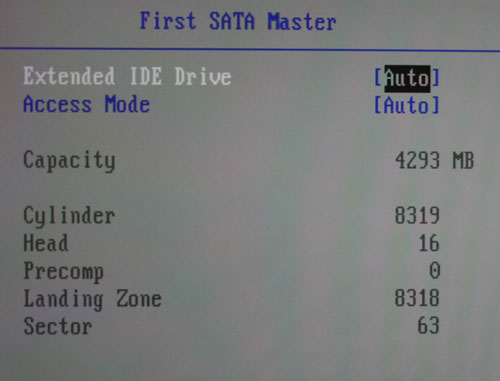
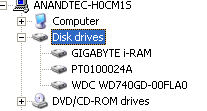
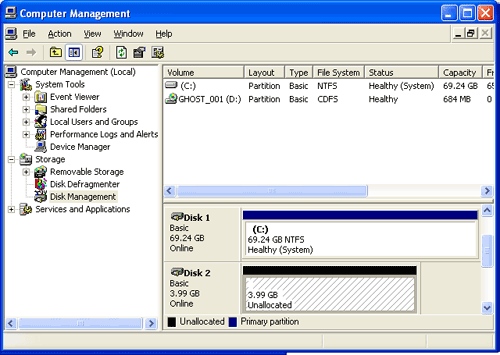
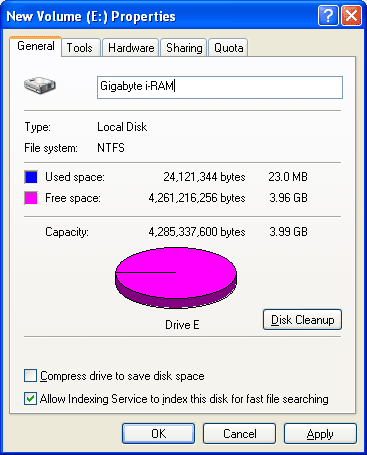
Also, all disk accesses are instantaneous; formatting the thing takes no time at all, and you can even "defragment" it (although, you get no benefit from doing so).
With the setup done, it was time to evaluate the i-RAM as more than just a novelty silent hard drive. Armed with our 4GB partition, we started testing...
The Test
We ran all of our tests on the following testbed unless otherwise noted:ASUS A8N SLI Deluxe nForce4 SLI Motherboard
AMD Athlon 64 FX-57 Processor
1 GB OCZ 2:2:2:7 DDR400 RAM
Seagate 7200.7 120 GB Hard Drive (boot drive)
Western Digital Raptor W740GD (test drive)
Gigabyte i-RAM w/ 4x1GB DDR400 modules (test drive)
We used the latest nForce 6.53 and ForceWare 77.72 drivers for our test bed, and paired it with the recently released GeForce 7800 GTX.










133 Comments
View All Comments
RobRedman - Saturday, October 7, 2006 - link
I must have 50 sticks of unused PC100 and PC133 SDRAM.Something like this for old RAM would be a value, (for me).
Does anyone know of an adapter that would take, lets say, 10 sticks of SDRAM and give me an IDE or USB connector?
ITLisa - Saturday, October 1, 2005 - link
I spent a little time looking for this and not even the manufacturer lists it on their sitemtownshend - Tuesday, March 14, 2006 - link
It was on Gigabytes site as I looked today and the past month while making the descion to get it.There's been a lag while retailers get rid of the v.1.2 and Gigabyte sends out the v1.3 cards.
I just got one of the new ones and will use it to run my FTP server application. I have 14 or 16 drives connected (6TB) to the server and previous reviews by others have pointed to the performance increse from the FTP app. searching and retaining the disk locations.
since I just got it I am not %100 on the reality, and the real benifit will be realized by the client seeking a file from the server. Using it for MS SQL Server is also a great idea. Other than that I haven't heard any real world uses, I mean users might be able to load Doom faster, but this device seems to be a bit expensive for most.
Also this card is bigger in area than most video cards, so if your box is crammed w/ wires or liquid pumps and resivours. The logistics of getting say 2 video cards and the RamDisk in a midsized case are pretty obsurd. Plus you need a fan or 2 in there to swirl around the heat generated by 3 heat monger cards) ...There goes more money in a bigger case.
For the general user, I would go with the new Raptor (the clear one) if you want to compromise speed, size and cost on a rational level.
Peace all
lrohrer - Tuesday, September 13, 2005 - link
The simplelist and best use of the i-ram is to store the "Temp DB" for SQL Server. MS SQL Server constanly writes to this database in most larger installations. It is temporary and by definitions does need to exist after reboot. (Alas SQL Server does not/CAN NOT keep this database in RAM) So on reboot a script will need to verify that it is still formatted and the appropriate file system/ files exist -- copied from the hard disk. SQL Serve is fussy about hardware so it masquerading as a disk is perfect.In an hour on google I can't find someone to sell it to my boss to try it out. sigh.
My prediction is a 5-10% boost to overall throughput on a SQL server installation with lots of "temp DB" activilty -- well worth the cost of the ram chips.
brandonbates - Friday, August 5, 2005 - link
I've been keeping an eye on ram disks for a little while now, but other than software they are just too expensive. The earlier post that had links to them (both flash and DRAM based disks) was the same stuff that I found. More recently I had been relieved by the availability of 64bit Systems and OSes with more slots/address space for ram and thus bigger ram disks. But it still really burned me that someoune couldn't make something really cheap that didn't rely on a big fat motherboard (which still has only so many slots, but admittedly faster).This qualifies. The second I heard about this while reading computex stuff I said to myself: Self, this thing only takes power from the PCI bus, therefore it would be a trivial thing to buy some PCI slots (like 8) and wire them for power, then raid or jbod these together and get one heck of database drive at a fraction of the cost of other solutions, and scaleable at that (I can start out with 2 or 3).
I also think it would be a nice (and easy) thing for them to put it in a 3.5" form factor with both molex and/or 3.3v standby loopthrough (through a pci dummy card or something). And yes 8 slots would be much more saleable, understanding that the mem controller may not support that (though some sort of bank switch would work since you have time to wait for the SATA or SATA2 bus, 3.5 form factor would get difficult with 8 slots though).
The situation that got me looking at this stuff is I have a mysql database (tested others as well) that has to do a table scan each time I do a query since it is a '%something%' query (loading web logs and running user demanded reports on them) The database is at around 4 gigs already (about 6 months worth, including 0.5GB packed indexes) and the report takes about two minutes (2 15k drives in RAID 1, not bad) But I still have to run it at night and make a summary table. (maybe a database with multithreaded partitions or grid would do it, but how much does that cost???!?) Anyway, my 2 cents (sorry for the long post). I'd really, really like to know what benchmarks say the latency for this thing is.
Zar0n - Tuesday, August 2, 2005 - link
For a mass product gigabyte needs to add.8 dimm slots
SATA2
Let's hope they do it fast...
ybbor - Friday, July 29, 2005 - link
What would happen if you stored a SQL database on the drive... wonder what it would do for database proformance benchmarks.you would probably back up to HD every night, or cluster with db on HD for data integrety
Chadder007 - Friday, July 29, 2005 - link
They should have went with a SATA II capable interface instead of regular SATA since it has much more capable bandwidth sitting there waiting to be used. Also the 4 gig of mem only hurts it a tad too.optiguy - Friday, July 29, 2005 - link
Now just as a thought to scary uses for the i-RAM. Law enforcement will hate these things. Peadophiles will have instant access to wiping there files without a trace, terrorist won't have to worry about the good guys being able to track their files.mindless1 - Friday, July 29, 2005 - link
Nope, pedos have a compulsive urge to collect stuff, 4GB wouldn't even come close. Besides, if the pedo was thinking that far in advance, there are plenty of already-existent technologies far more secure. When the cops come busting down someone's door, do you think they'll saw something like "freeze, don't move, unless you prefer to go over to your computer and wipe data!" ? Then again, general ignorance about the need to keep the evidence battery charged could be an issue.